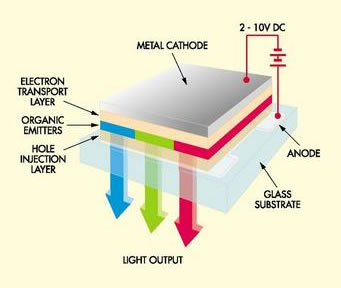Big Advance in OLED Lighting Might Signal Beginning of the End for the Bulbs May 18, 2009
Posted by Dr. Z Bulbs in Definitions about product., LED Lights, light bulb, List Article.Tags: Energy saving, energy saving bulb, energy saving light bulb, energy saving lighting, LED, led lighting, light bulb, light bulbs, lightbulb, OLED, Technology of a light bulb
trackback

OLED Diagram
Gadzooks! The search for the perfect light source continues. OLEDs are they the future? Check out the posting below.
Dr. Z
P.S. I included a brief definition of OLEDs at the begining. Thanks to Wikipedia!
An organic light emitting diode (OLED), also light emitting polymer (LEP) and organic electro luminescence (OEL), is any light emitting diode (LED) whose emissive electroluminescent layer is composed of a film of organic compounds. The layer usually contains a polymer substance that allows suitable organic compounds to be deposited. They are deposited in rows and columns onto a flat carrier by a simple “printing” process. The resulting matrix of pixels can emit light of different colors.
Such systems can be used in television screens, computer displays, small, portable system screens such as cell phones and PDAs, advertising, information and indication. OLEDs can also be used in light sources for general space illumination, and large-area light-emitting elements. OLEDs typically emit less light per area than inorganic solid-state based LEDs which are usually designed for use as point-light sources.
A significant benefit of OLED displays over traditional liquid crystal displays (LCDs) is that OLEDs do not require a backlight to function. Thus they draw far less power and, when powered from a battery, can operate longer on the same charge. Because there is no need for a backlight, an OLED display can be much thinner than an LCD panel. Degradation of OLED materials has limited their use so far.[1]
The up-and-coming electronics technology known as organic light-emitting diodes (OLEDs) has spent the week in the, yes, spotlight. Earlier this week researchers announced that they had joined OLEDs to a rubbery conductor to make a computer display screen that could be bent, folded, and crumpled. Now, another team has tweaked OLEDs to make ultra-efficient panels that produce a white light similar to that produced by traditional incandescent light bulbs. Study coauthor Karl Leo says some big technical hurdles still need to be overcome, but adds: “I’m pretty convinced that in a few years OLEDs will be a standard in buildings” [BBC News].
Incandescent lighting is being phased out in some parts of the world because it isn’t energy efficient, and it’s being replaced by compact fluorescent bulbs or light-emitting diode (LED) fixtures. But with both fluorescent and LED lighting, the quality of white light produced has always left something to be desired. Fluorescent lighting can make people appear unhealthy because less red light is emitted, while most white LEDs on the market today have a bluish quality, making them appear cold [Technology Review]. In contrast, OLEDs, which are made from organic compounds that emit light when electricity is passed through them, can provide a nice white light, but efficiency problems have held the technology back.
As the researchers explain in a paper in Nature, their modifications boosted OLED’s efficiency past that of traditional lighting sources. Their improved device yielded 90 lumens (a measurement of brightness) per watt of electricity consumed…. This compared to 15 lumens for a conventional incandescent light bulb and between 50 and 70 lumens per watt for modern compact fluorescent light bulbs [AFP]. They produced the efficiency gain with a series of technical adjustments. One trick was to make the outer surfaces of the device from types of glass that have optical properties that more closely match those of the device substrate. Otherwise, much of the emitted light is reflected and either reabsorbed or lost through heat. “In conventional structures, about 80 percent of the light is lost,” [Technology Review], says study coauthor Sebastian Reineke.
But the technology still faces several large obstacles:. Just like previous white OLEDs, the devices degrade within an hour or two, because the polymers that produce the blue part of the light are unstable. However, Professor Leo said that promising first results on stable, phosphorescent blue polymers are starting to emerge. “I’m personally convinced that it may take a few years, but chemists will solve this problem and find materials which are stable enough,” he said [BBC News]. OLEDs are also expensive to produce, but researchers hope that the material can soon be produced in large sheets, making it commercially viable.
Related Content:
80beats: Rubbery Computer Screens Can Be Bent, Folded, and Even Crumpled
DISCOVER: Future Tech shows why the light bulb is becoming as quaint as a vacuum tube
Image: F. Erler / N. Seidler

I would love to see a wall of OLEDs usable as a screen as well, so we could use them instead of projectors, and with wireless techology in place of computer montiors. Why not watch movies, view a photo album, do some recipe research?